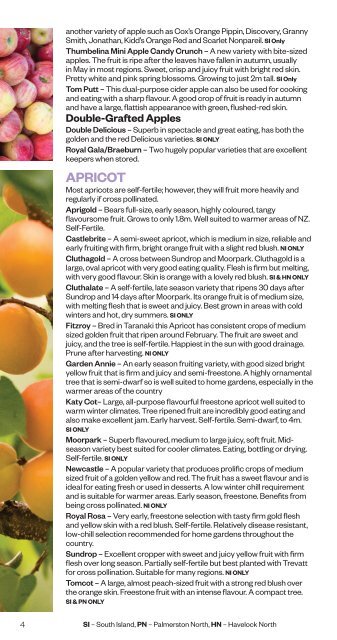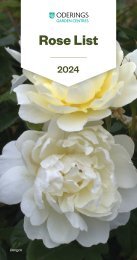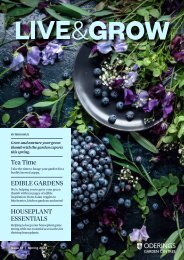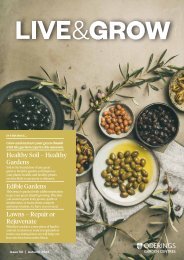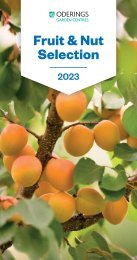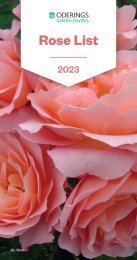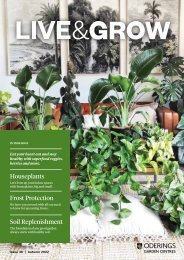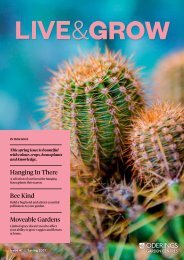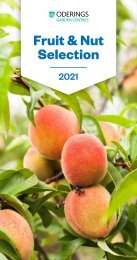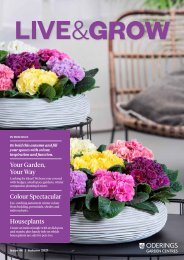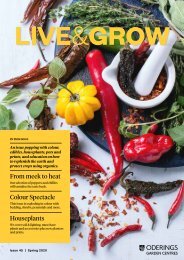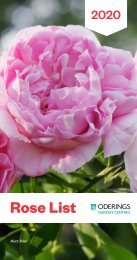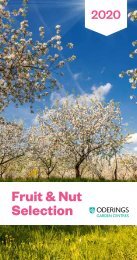Fruit & Nut Selection 2024
Discover our wide array of fruit and nut trees available, including apples, pears, plum trees, and many more options.
Discover our wide array of fruit and nut trees available, including apples, pears, plum trees, and many more options.
You also want an ePaper? Increase the reach of your titles
YUMPU automatically turns print PDFs into web optimized ePapers that Google loves.
another variety of apple such as Cox’s Orange Pippin, Discovery, Granny<br />
Smith, Jonathan, Kidd’s Orange Red and Scarlet Nonpareil. SI Only<br />
Thumbelina Mini Apple Candy Crunch – A new variety with bite-sized<br />
apples. The fruit is ripe after the leaves have fallen in autumn, usually<br />
in May in most regions. Sweet, crisp and juicy fruit with bright red skin.<br />
Pretty white and pink spring blossoms. Growing to just 2m tall. SI Only<br />
Tom Putt – This dual-purpose cider apple can also be used for cooking<br />
and eating with a sharp flavour. A good crop of fruit is ready in autumn<br />
and have a large, flattish appearance with green, flushed-red skin.<br />
Double-Grafted Apples<br />
Double Delicious – Superb in spectacle and great eating, has both the<br />
golden and the red Delicious varieties. SI ONLY<br />
Royal Gala/Braeburn – Two hugely popular varieties that are excellent<br />
keepers when stored.<br />
APRICOT<br />
Most apricots are self-fertile; however, they will fruit more heavily and<br />
regularly if cross pollinated.<br />
Aprigold – Bears full-size, early season, highly coloured, tangy<br />
flavoursome fruit. Grows to only 1.8m. Well suited to warmer areas of NZ.<br />
Self-Fertile.<br />
Castlebrite – A semi-sweet apricot, which is medium in size, reliable and<br />
early fruiting with firm, bright orange fruit with a slight red blush. NI ONLY<br />
Cluthagold – A cross between Sundrop and Moorpark. Cluthagold is a<br />
large, oval apricot with very good eating quality. Flesh is firm but melting,<br />
with very good flavour. Skin is orange with a lovely red blush. SI & HN ONLY<br />
Cluthalate – A self-fertile, late season variety that ripens 30 days after<br />
Sundrop and 14 days after Moorpark. Its orange fruit is of medium size,<br />
with melting flesh that is sweet and juicy. Best grown in areas with cold<br />
winters and hot, dry summers. SI ONLY<br />
Fitzroy – Bred in Taranaki this Apricot has consistent crops of medium<br />
sized golden fruit that ripen around February. The fruit are sweet and<br />
juicy, and the tree is self-fertile. Happiest in the sun with good drainage.<br />
Prune after harvesting. NI ONLY<br />
Garden Annie – An early season fruiting variety, with good sized bright<br />
yellow fruit that is firm and juicy and semi-freestone. A highly ornamental<br />
tree that is semi-dwarf so is well suited to home gardens, especially in the<br />
warmer areas of the country<br />
Katy Cot– Large, all-purpose flavourful freestone apricot well suited to<br />
warm winter climates. Tree ripened fruit are incredibly good eating and<br />
also make excellent jam. Early harvest. Self-fertile. Semi-dwarf, to 4m.<br />
SI ONLY<br />
Moorpark – Superb flavoured, medium to large juicy, soft fruit. Midseason<br />
variety best suited for cooler climates. Eating, bottling or drying.<br />
Self-fertile. SI ONLY<br />
Newcastle – A popular variety that produces prolific crops of medium<br />
sized fruit of a golden yellow and red. The fruit has a sweet flavour and is<br />
ideal for eating fresh or used in desserts. A low winter chill requirement<br />
and is suitable for warmer areas. Early season, freestone. Benefits from<br />
being cross pollinated. NI ONLY<br />
Royal Rosa – Very early, freestone selection with tasty firm gold flesh<br />
and yellow skin with a red blush. Self-fertile. Relatively disease resistant,<br />
low-chill selection recommended for home gardens throughout the<br />
country.<br />
Sundrop – Excellent cropper with sweet and juicy yellow fruit with firm<br />
flesh over long season. Partially self-fertile but best planted with Trevatt<br />
for cross pollination. Suitable for many regions. NI ONLY<br />
Tomcot – A large, almost peach-sized fruit with a strong red blush over<br />
the orange skin. Freestone fruit with an intense flavour. A compact tree.<br />
SI & PN ONLY<br />
Trevatt – Large sweet, juicy golden-yellow fruit. Mid to late season. Eating<br />
or bottling. Recommended for most areas. Pollinate with Sundrop. SI ONLY<br />
Apricot Double<br />
Sundrop/Trevatt – Two top varieties combined, both being the ideal<br />
choice for most regions throughout New Zealand.<br />
CHERRY<br />
Some cherries are self-fertile, whereas others need a cross pollinator.<br />
Bing – Dark red with a beautiful, acidic, excellent flavour. Bing is the main<br />
cheery grown in the USA Pacific and Northwest, but fruit size is small. HN<br />
ONLY<br />
Burlat – Is the standard early season cheery with dark red skin and flesh.<br />
Medium to large sized fruit for its season. NI ONLY<br />
Compact Stella – Heavy and regular bearer of large dark red fruit with<br />
firm light-red flesh. Self-fertile and one of the best known sweet cherries.<br />
Grows to around 3m.<br />
Dawson – Superb eating black medium-size fruit with firm red flesh.<br />
Ripens just after Christmas. Pollinators: Lapins and Stella.<br />
Lapins – Large dark red fruit with firm juicy flesh. Self-fertile, precocious<br />
and now a commercial mainstay in many areas. Mid to late season.<br />
Montmorency – Most widely grown sour cherry in the USA. Great for<br />
cherry pie and juice. Bright red skin with white flesh. Amorelle-type cherry<br />
with clear juice. Self-Fertile. SI ONLY<br />
Rainier – Large super sweet, white fruit with red blush and white flesh.<br />
Early to mid-season. Pollinate with Stella. SI ONLY<br />
Stella – Heavy and regular bearer of large dark red fruit with firm light-red<br />
flesh. Self-fertile and one of the best-known sweet cherries.<br />
Grows to 5m plus.<br />
FIGS<br />
All figs are self-fertile.<br />
Brown Turkey – Well-known hardy selection with large crops of green<br />
figs with distinguishing brown tinge. White to amber flesh. Eats OK but<br />
best for culinary uses.<br />
Brunoro Black – A prolific cropper producing two crops in warmer areas.<br />
Sweet, smallish dark-skinned fruit with red flesh. Attractive foliage with<br />
strongly divided leaves.<br />
Mrs Williams – Good quality large fig that is earlier than most. <strong>Fruit</strong> dark<br />
in colour, sometimes purple. Flesh light amber to rich red.<br />
NASHI<br />
Nashi are self-fertile; however, they will fruit more heavily and regularly if<br />
cross pollinated.<br />
Hosui – Excellent eating, sweet and juicy with good acid balance and fine<br />
texture. Large russet golden-brown fruit. Partially self-fertile. Mid-season.<br />
Nijiseiki – Very juicy, sweet, creamy white, crisp medium-size round fruit.<br />
Self-fertile and good pollinator of Hosui. Mid-season.<br />
Double Nashi<br />
Hosui/Nijiseiki – Particularly suitable where space is limited as these<br />
varieties pollinate each other. PN ONLY<br />
NECTARINE<br />
All varieties are self-fertile and will crop well on their own.<br />
Early Red – Very early to fruit with yellow flesh and red blushed skin.<br />
Good balance of sweet and tart flavour. Freestone. Good easing and fruit<br />
size.<br />
Fantasia – An excellent yellow-fleshed selection producing large<br />
attractive fruit with very good flavour. Freestone. Low chill requirements<br />
so suitable for warmer climates. Late season.<br />
4 SI – South Island, PN – Palmerston North, HN – Havelock North<br />
www.oderings.co.nz<br />
5


